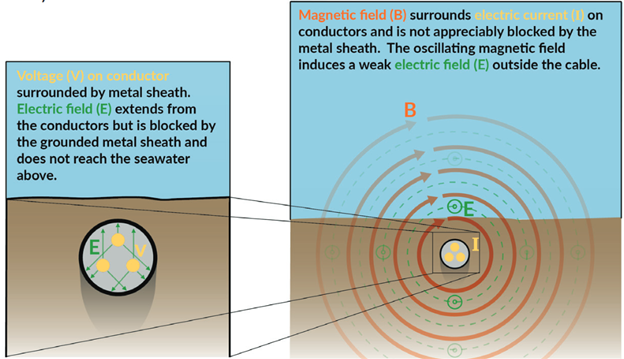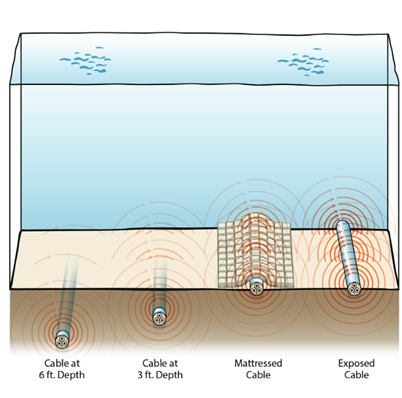Breadcrumb
- California Offshore Winds
- Electromagnetic Fields
Electromagnetic Fields
A major part of the offshore wind development will include seabed cables. These cables include both array cables and export cables. The array cables (which can be either static or dynamic) connect the turbines in a windfarm take power from wind farm and transfer it to offshore substation. Higher capacity export cables deliver power from the offshore substation to onshore for distribution into a grid. All of the cables have a conductive metal core covered by insulation and some sort of containment material.
- What socio-environmental impacts are possible with the offshore wind cables?
While delivering power to substations, offshore wind cables on the seabed floor, offshore wind cables on the seabed floors may generate electromagnetic (EMF) fields. These fields are detectable by some marine organisms. Researchers have explored and continue to investigate whether changes in EMF might impact specific habitats including breeding regions, foraging regions, and migration areas.
Outside of EMF, cables on the seabed floor can physically interrupt benthic communities and interfere with certain types of fishing practices.
- What causes electromagnetic fields?
The earth has natural geomagnetic fields. In addition to these fields, undersea power cables can generate alternating current and direct current. Cables wrapped in a sheath will eliminate direct electric fields and reduce magnetic and induced electric fields. EMF dissipates with distance above the seabed.
Image
- What marine animals might be impacted by changes in EMF?
Many marine animals living in the water-column and on the seabed floor can detect EMF. Water column animals include turtles, whales, sharks, squids, and bony fish. Bottom-dwelling animals include bony fish, skates, crabs, shellfish, and lobsters.
- What do we know about potential impacts of EMF on marine species?
Some species including skates, sharks, crabs, and lobsters may be sensitive to EMF. Elasmobranchs such as sharks seem to be attracted to alternating currents rather than direct current. [3] It has not been assessed whether elasmobranchs will become habituated to cables. The EMF effects on individuals dissipate with distance from a cable. Burial of cables in the seabed floor 1-2 meters (3-6 feet) or protection of the cable with a concrete “mattress” will minimize EMF exposures. Increasing the burial depth from 3 feet to 6 feet reduces the magnetic field along the seafloor by approximately four-fold.
Image
There is substantial research going on to understand the impact of EMF on different species. For example, one group of studies has found no impact on Dungeness crabs and rock crabs in crossing AC-powered cables. [1] Other studies suggest some behavioral change for Dungeness crabs exposed to DC magnetic fields. [2]
There is limited research on the impact of cables on the thermal environment. Fishers have observed that some animals such as lobsters seem to concentrate along cable routes which could be because of EMF, warmth, or some other factor. [3]
High voltage AC cables may have limited impacts on fishing migrating between freshwater and sweater such as lampreys, eels, herrings, and salmons. Even when cables are ground, the magnetic field emitted and movement of animals/water currents can create electric fields. (*} Exposure to HVDC cables may affect the swimming speed of a fish (haddock larvae) (**) and travel speed of lobsters (***). Some of these studies are done in laboratories. Researchers continue to study EMF and what is clear is that different species have different behavioral responses to underwater cable-generated EMF.
*Gill, A.B. and M. Desender. 2020. Risk to Animals from Electro-magnetic Fields Emitted by Electric Cables and Marine Renewable Energy Devices. In A.E. Copping and L.G. Hemery (Eds.), OES-Environmental 2020 State of the Science Report: Environmental Effects of Marine Renewable Energy Development Around the World. Report for Ocean Energy Systems (OES). (pp. 86-10). DOI: 10.2172/1633088.
** Cresci A, Durif C M F, Larsen T, Bjelland R, Skiftesvik A B and Browman H I 2022 Magnetic fields produced by subsea high-voltage direct current cables reduce swimming activity of haddock larvae (Melanogrammus aeglefinus) PNAS Nexus Volume 1, Issue 4, September 2022, pgac175, https://doi.org/10.1093/pnasnexus/pgac175
*** Hutchison, Z.; Sigray, P.; He, H.; Gill, A.; King, J.; Gibson, C. (2018). Electromagnetic Field (EMF) Impacts on Elasmobranch (shark, rays, and skates) and American Lobster Movement and Migration from Direct Current Cables (Report No. BOEM 2018-003). Report by University of Rhode Island. Report for Bureau of Ocean Energy Management (BOEM)
- What do we need to know more about for floating offshore wind projects related to EMFs?
We need to learn more about the extent of EMFs associated with inter-array (connecting turbines within a farm to substations) and export cables (taking power to the land substations) on particular species. Limited information is available about EMF impacts on a subset of Pacific Ocean species (e.g. Pacific lamprey, Pacific electric ray). [4] Resident populations near a cable area could be attracted, repelled or unaffected by power cables but more research is needed. [4] NOAA researchers commented in 2023 that “Knowledge of species responses to EMFs is patchy and derived from a variety of methods (e.g., aquariums…[different types of field experiments]) often using different exposure types in assessments, making it difficult to establish impacts in the context of OSW. A better characterization of the EMFs would enable more contextually relevant effect/impact studies to be designed for the species of interest. Species life stage and movement ecology must factor into assessments of effects, including the likelihood of encountering a cable EMF and/or multiple OSW cables and the potential for cumulative effects.” Decisions about mitigation measures such as cable burial will depend on the sensitivity of specific species found in the vicinity of a power cable.
- What can the West Coast learn from the East Coast about cable placement?
The West Coast may want to insist that cables be installed to recommended depths using reliable methods. In 2016, the Block Island Wind Farm turbines were connected to the mainland with nearshore cables that when exposed created a hazard for swimmers, boaters, and fishers. The recommendation had been for the cables to be installed at 8-10 feet for the particular location, but the permitting agency had permitted the cables to be installed at 4-foot depth. In subsequent East Coast offshore wind projects, wind developers agreed to bury cables making landfall using horizontal directional drilling techniques at significantly deeper depths (50 feet) to avoid conflicts with beach or waterfront use.
- References
[1] Love MS, Nishimoto MM, Clark S, McCrea M, Bull AS. 2017. Assessing potential impacts of energized submarine power cables on crab harvests. Cont Shelf Res. 151:23-29
[2] Woodruff et al. 2012. Effects of electromagnetic fields on fish and invertebrates task 2.1.3: effects on aquatic organisms; fiscal year 2011 progress report. Pacific Northwest National Laboratory. Prepared for the U.S. Department of Energy. Contract No. DE-AC05-76RL01830. Accessible at https://www.pnnl.gov/main/publications/external/technical_reports/PNNL-20813Final.pdf.
[4] Bureau of Ocean Energy Management, Effects of EMFs from Undersea Power Cables on Elasmobranchs and Other Marine Species, OCS Study, BOEMRE 2011-09 https://www.boem.gov/sites/default/files/environmental-stewardship/Environmental-Studies/Pacific-Region/Studies/2011-09-EMF-Effects.pdf